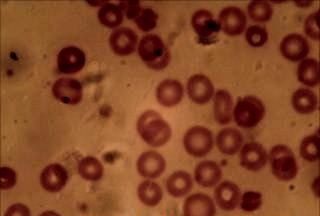Rejuvenating blood by reprogramming stem cells
March 27, 2013

Human blood magnified 600 times (credit: John Alan Elson/Wikimedia Commons)
Lund University researchers have succeeded in rejuvenating the blood of mice by reversing, or reprogramming, the stem cells that produce blood.
Stem cells form the origin of all the cells in the body and can divide an unlimited number of times. When stem cells divide, one cell remains a stem cell and the other matures into the type of cell needed by the body, for example a blood cell.
“Our aging process is a consequence of changes in our stem cells over time”, explained Martin Wahlestedt, a doctoral student in stem cell biology at the Faculty of Medicine at Lund University and lead author of a forthcoming article in the journal Blood.
“Some of the changes are irreversible, for example damage to the stem cells’ DNA, and some could be gradual changes, known as epigenetic changes, that are not necessarily irreversible, even if they are maintained through multiple cell divisions. When the stem cells are reprogrammed, as we have done, the epigenetic changes are cancelled.”
The discovery that forms the basis for the research group’s method was awarded the Nobel Prize in Medicine last year.
The composition of blood is one example of how it ages; blood from a young person contains a certain mix of B- and T-lymphocytes and myeloid cells. “In older people, the number of B- and T-lymphocytes falls, while the number of myeloid cells increases”, said Wahlestedt.
When an elderly person is affected by leukemia, the cancer often has its origin in the myeloid cells, of which the elderly have more. Being able to “restart” the blood, as Martin and his colleagues have done in their studies on mice, presents interesting possibilities for future treatment.
“A critical factor that gives an indication of whether the procedure is going to work or not is the age of the bone marrow donor. By reversing the development of the stem cells in the bone marrow, it may be possible to avoid negative age-related changes.”
Wahlestedt stressed that the science is still only at the stage of basic research, far from a functioning treatment. However, the research group is pleased with the results, because they indicate that it may not primarily be damage to DNA that causes blood to age, but rather the reversible epigenetic changes.